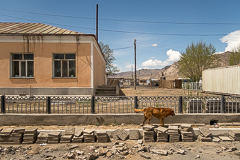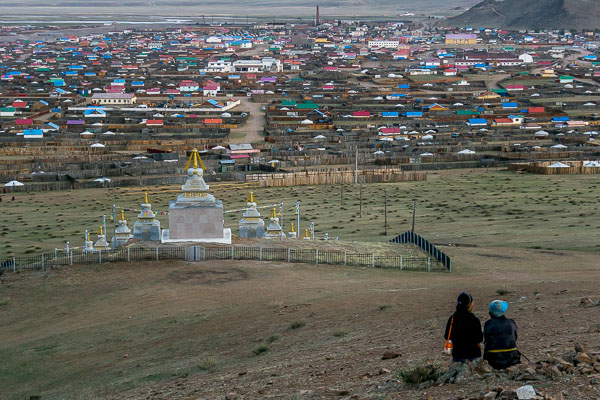Central Aimag Cities

Sidewalk Rebuilding, Uliastai
There is the central square, plaza, or other wide open space in the middle of the town. In larger towns it may be paved, but in smaller towns it may just be dirt. There is often a statue or monument there, in a style, depending on its age, that ranges from large heroic bronzes to late-Soviet modernist assemblages of metal and concrete. In this largely Buddhist country, there are Buddhist temples, and if the town has a high spot or a hill, an additional shrine that can be reached by stairs. There are ger districts, the suburbs that expand from the central business area to the flexible and moving edge of town, and there are apartments and offices that are invariably covered with stucco that is painted in an individualized color. A year ago I spent time in the suburbs of Dallas, where surely there is a law saying that all roofs must be tan. Here new metal roofs are any color you can imagine and some that you can't, though there is still a preference for red, blue, and green.
Despite the similarities, there are also some differences brought about by circumstances that give each of these towns a different personality. One of these circumstances is size, which is related to another, money, the economic circumstances of each town depending on its proximity to some business activity. Bayankhongor seems to be doing pretty well, I was told, because of mining that is happening to the south. Altai, still growing, does not seem to be getting quite the same benefit. Uliastai has several smaller projects under way, such as sidewalk reconstruction and road paving, but otherwise seems the same as it did two years ago. Even in the most prosperous cities, new housing, except apartment buildings, is not built with running water, and residents use a pit toilet in the corner of their hashaa.
The biggest differences though are those of each town's geographic location, governing everything from the grazing capacity of the surrounding area to the physical limits of expansion, something that usually is not a problem in Mongolia. (We passed quickly through Tsetserleg, the capital of Arkhangai aimag, but did not stop. It is surrounded on the north with steep cliffs.) Geography provides the view that you take in from each town's center or temple or shrine. It determines how easy or hard it is to get material into the city, or for those trying to sell to the rest of Mongolia, how hard it is to get it out. Jargalant in Khovsgol aimag has both trees and sawmills, as well as one of the least used dirt paths of any town we visited. Our two river crossings on the way in were made through the river instead of on the abandoned bridges that crumbled above.



